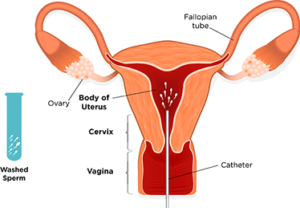Intrauterine insemination is a fertility treatment that involves placing sperm inside a woman’s uterus to facilitate fertilization. The goal of IUI is to increase the number of sperm that reach the fallopian tubes and subsequently increase the chance of fertilization.
What is IUI?
IUI involves a laboratory procedure to separate fast-moving sperm from more sluggish or non-moving sperm. It can be performed with your partner’s sperm or donor sperm.
Is IUI for me?
You may be offered IUI if:
- You are using donated sperm in your treatment.
- You are unable (or would find it very difficult) to have vaginal intercourse, for example because of a physical disability or psychosexual problem
- You have a condition that means you need specific help to conceive (for example, if you’re a man who is HIV positive and you have undergone sperm washing to reduce the risk of passing on the disease to your partner and potential child).
- In the past IUI was offered if you had unexplained infertility, mild endometriosis or when a male partner had mild fertility problems.
IUI OPTIONS
If your clinic has recommended IUI treatment, you may want to have a discussion with your clinician about the risks involved in using fertility drugs to boost egg production and whether IUI without fertility drugs might be suitable for you.
How does IUI work?
Patency health tests
IUI can only begin once it has been confirmed that your fallopian tubes are open and healthy. This will usually be checked through a tubal patency test as part of your assessment by the fertility clinic.
This may involve a laparoscopy, an operation in which a dye is injected through your cervix as the pelvis is inspected for blockages with a telescope that has a tiny camera attached .
Alternatively, you may undergo a hysterosalpingo-contrast sonography – which involves using a vaginal ultrasound probe to check the fallopian tubes for blockages – or a hysterosalpingogram, an x-ray of your fallopian tubes.
The procedure
For women
If you are not using fertility drugs, IUI will be performed between day 12 and 16 of your monthly cycle – with day one being the first day of your period. You will be given blood tests or urine tests to identify when you are about to ovulate.(OR)If you use fertility drugs to stimulate ovulation, vaginal ultrasound scans are used to track the development of your eggs. As soon as an egg is mature, you are given a hormone injection to stimulate its release.
The sperm will be inserted 36–40 hours later. The doctor will first insert a speculum into your vagina, as in a smear test, to keep your vaginal walls apart. A small catheter will then be threaded into your womb via your cervix. The best-quality sperm will be selected and inserted through the catheter.
The whole process only takes a few minutes and is usually painless. Some women may experience a temporary, menstrual-like cramping. You may want to rest for a short time before going home.
For men:
You will be asked to produce a sperm sample on the day the treatment takes place. The sperm will be washed to remove the fluid surrounding them and the rapidly moving sperm will be separated out from the slower sperm. The rapidly moving sperm will be placed in a small catheter to be inserted into the womb.

Intrauterine Insemination ( IUI) ( Husband / Donor)
Intrauterine insemination ( lUI ) is an infertility treatment that is commonly known as artificial Inseminisation. This procedure involves injecting the woman with specially prepared sperm. Most of the time the woman is also treated with medicines that stimulate ovulation before lUI.
Process of IUI
This procedure is quite simple and takes about 5-10 minutes, usually it is a painless procedure. First A speculum is inserted into the vagina which will aid visualizing the cervix. A mild cleaning solution is used to clean the cervix and surrounding vaginal tissue. Then the washed sperm is drawn into a syringe with a tiny catheter attached. Finally the catheter is passed through the cervix and then the sperm is injected into the uterus. The catheter and speculum is now removed and the patient is asked to rest for a short period of time, approx 15-30 min. After the IUI is completed,There is no need of bed rest in the IUI procedure.

